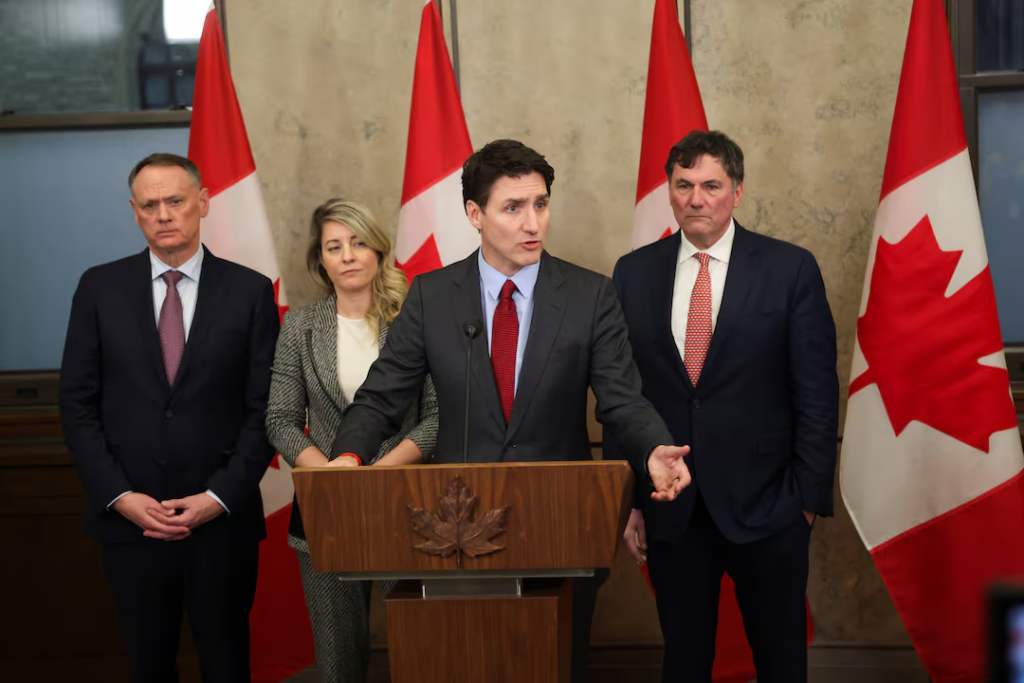Prime Minister Justin Trudeau has announced a sweeping set of retaliatory tariffs on U.S. imports. In what is being widely dubbed the Justin Trudeau tariffs initiative, the Canadian leader unveiled his strategy during a high-profile Justin Trudeau press conference in Ottawa, directly responding to President Donald Trump’s aggressive tariff measures. This move marks a significant escalation in the long-standing trade dynamics between Canada and the United States.
Justin Trudeau’s Tariff Response
Speaking at a press conference that reverberated through both domestic and international media, Trudeau condemned the U.S. tariffs as a “declaration of economic war” against Canada. His Justin Trudeau response outlined a plan to impose 25% tariffs on approximately C$155 billion ($107 billion) worth of U.S. goods. The announcement specified that tariffs on goods valued at C$30 billion would be effective starting Tuesday—the same day that Trump’s tariffs took effect—with the remaining tariffs on C$125 billion set to roll out in 21 days.

Trudeau was emphatic about the consequences, stating, “Tariffs against Canada will put your jobs at risk, potentially shutting down American auto assembly plants and other manufacturing facilities.” He highlighted that the U.S. would not only feel the economic strain but that Canadian consumers and industries would also face significant challenges. In his measured yet resolute tone, Trudeau stressed that these tariffs were a reluctant but necessary countermeasure, declaring, “We didn’t ask for this, but we will not back down.”
What Does Trudeau’s Tariff Response Mean for North America?
The retaliatory tariffs are set to target a diverse portfolio of U.S. imports including beer, wine, bourbon, fruits, fruit juices—such as orange juice from Florida—along with clothing, sports equipment, household appliances, and even lumber and plastics. Trudeau’s measures aim to hit sectors that are economically significant for the U.S., thereby underscoring the seriousness of Canada’s tariff response. The Canadian government has also hinted at additional non-tariff measures, potentially focusing on critical minerals and energy procurement, to further bolster its stance.
Trudeau’s announcement arrives as the world’s longest undefended border sees daily trade exceeding $2.5 billion, predominantly in energy and manufacturing sectors. With U.S.-Canada trade accounting for roughly 17.8% of Canadian GDP and more than 2.4 million jobs, the stakes are high. In an era where global supply chains are under intense scrutiny, Trudeau’s tariffs represent a pivot in trade policy aimed at safeguarding national interests amid a deteriorating bilateral relationship.
Trump’s Tariffs and the Escalation of a Trade War
The backdrop for Trudeau’s decisive actions is President Donald Trump’s tariff imposition on Canada, Mexico, and China. Trump’s tariffs, which include a 25% levy on imports from Canada and Mexico and a 10% tariff on goods from China, were framed as a response to issues ranging from illegal immigration to the influx of contraband drugs like fentanyl. In his own defense, Trump argued that these tariffs were essential to protect American jobs and national security. However, Trudeau’s response makes it clear that any aggressive trade action by the U.S. will be met with equally robust measures.
Trump’s policies have been controversial, igniting fierce debates over the efficacy and consequences of such protectionist measures. Trudeau’s counter-tariffs highlight not only a battle over trade imbalances but also a clash of diplomatic philosophies—where Trump’s unilateral actions are being met with collective Canadian resolve.
When Justin Trudeau’s Term Ends: Political Implications
The timing of these developments is particularly significant as Trudeau’s political future hangs in the balance. With his party in the midst of a leadership race, many have been asking when Justin Trudeau term ends and what impact these decisions might have on the upcoming political landscape in Canada. Trudeau has indicated that he plans to step down once a new Liberal Party leader is chosen, marking the end of nearly a decade in office. His handling of the tariff crisis is likely to be a defining moment in his legacy—balancing between the need to assert Canadian sovereignty and the complexities of an intertwined North American economy.
Political analysts predict that the economic fallout from the escalating trade war could influence voter sentiment, potentially benefiting the opposition. Despite these pressures, Trudeau has remained steadfast, emphasizing his commitment to protecting Canada’s economic interests even in the face of significant political uncertainty.
U.S. Trade War: What Can We Expect?
The current standoff between Canada and the U.S. is symptomatic of a broader global trend towards protectionism and unilateral economic policies. Trudeau’s decision to impose the Justin Trudeau tariffs is not just a countermeasure; it is a declaration of national sovereignty. His unequivocal stance at the press conference served as a reminder that the deep economic interdependence between the two nations requires a balanced, reciprocal approach to trade—a sentiment that resonates across the continent.
As both countries brace for potential economic disruptions, the coming weeks will be critical in shaping the future of North American trade relations. The evolving dispute highlights the intricate connections between policy, economy, and national security—a reality that both Trudeau and Trump must face as they assert their respective visions for the future.


